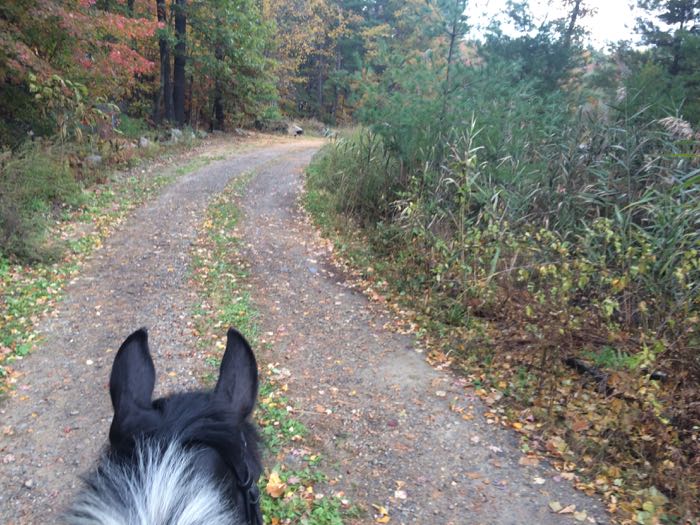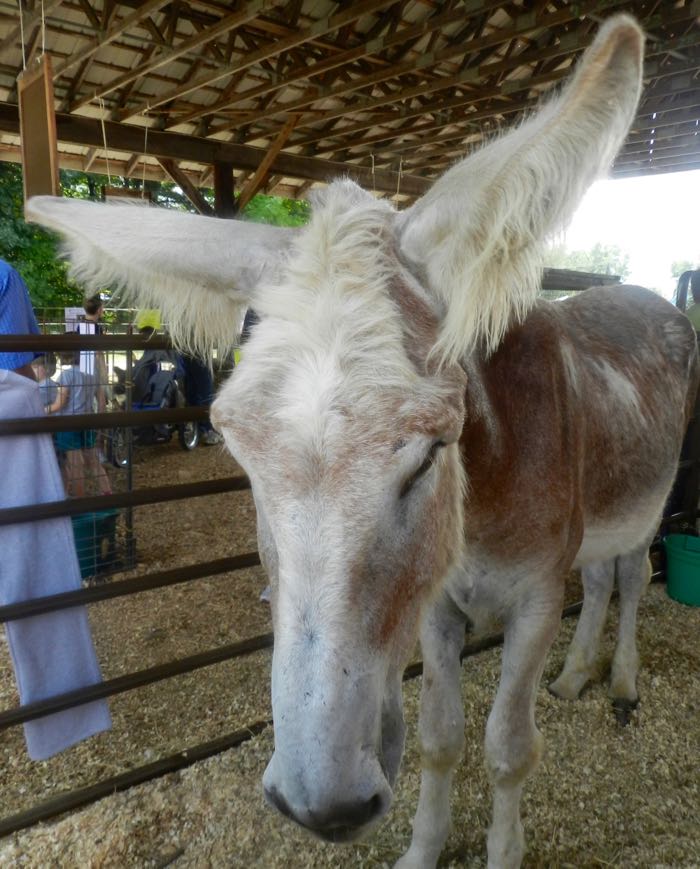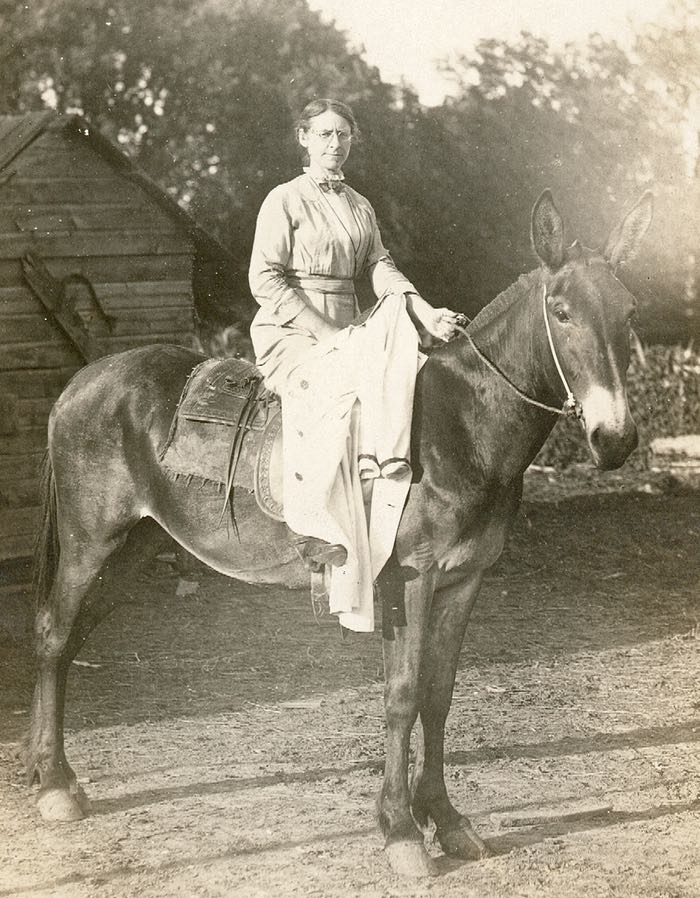The affectionate term for donkeys and mules is long ears. As much as I adore Tonka’s pert, turned-in ears, and especially as much as I love looking straight through them to the trail,
there is something about big fuzzy ears that makes me swoon.
These long ears belong to a animal saved by the Save Your Ass Rescue – perhaps the best-named rescue, ever. If you’re looking for a 2016 calendar, they have one. Get it to support a very good cause.
I’ve been on week-long riding treks through wilderness mountains, me on a sensible horse, the guide on an even more sensible mule. Horses flee when scared. Mules stay put and assess the situation. This is how they got their reputation for being stubborn. They know more than you. It’s good to trust a mule.
Before getting Tonka, I thought about getting a mule. Something like this.
I have the wherewithal to have only one large four-legged animal, and I’m grateful to have found my heart horse in Tonka. But, oh, those ears!
If you have experience with long ears, let me know in the comments.




You might enjoy this mule story:
http://www.nuggetnews.com/main.asp?Search=1&ArticleID=24320&SectionID=6&SubSectionID=6&S=1
I’ve heard about this mule! Thanks for sharing.
I, too, admire long ears. But from afar, no personal experience. I learned to ‘love’ them listening to the stories my dad told. Though not all his stories were fan based! :) (My grandfather did not buy a tractor for plowing till -after- my dad graduated high school and joined the Navy. :D )
There are many reasons why tractors took over the jobs of mules, and most of them are valid! Farming is hard work, for people and beasts.
I have little experience with longears, but that is one handsome mule!
Your next dressage “horse”? I hear they have few lameness issues :)
Two observations: You are absolutely right. “Save Your Ass Rescue” is, indeed, the best named rescue organization, ever. And, you have to love a picture of a woman riding a mule….sidesaddle. Flair on a mule.
I have not had the pleasure of working with mules. But I know many really experienced riders and a few trainers who adore them and who swoon and smile whenever they’re mentioned. Like you, Terry.
Actually, as I look closer, the dour woman astride the well groomed mule is sitting not in a side saddle, but a horned western saddle. What I mistook for her left foot is an illusion created by an over jacket thrown over the horn and draped over the horses withers and shoulders, perhaps for modesty’s sake during the photo session! I think Terry is too polite to correct me.
Not too polite, you caught it first :) I believe that the coat is what is called a “duster” – very useful to protect dresses from, you guessed it, dust. As you can imagine, dirty clothes were not just tossed into a washing machine, and you did what you could to keep your good clothes clean. Western women rode astride, even in dresses. In fact, the reason that pants became acceptable was because western women, by necessity doing ranch chores, had to wear pants or split skirts. That style was seen back east on the cover of dime novels, (very popular) and became fashionable to women who’d never been on a horse. Without the horsewomen out west, pants would have taken much longer to become acceptable attire!
I think I have mentioned before that I rode a mule down the Grand Canyon with a mule train. If I had a choice between a horse and a mule, the mule would come home with me. I love them, even though I know little to nothing about caring for a horse or mule. At my age I can only dream!
Dreams are fine :)
My grandpa had two. What I remembered about them was they DID NOT LIKE children.
We could only pet or help groom them when grandpa was around and when they were tethered on both sides and they still tried to turn and bite and the one would body slam the side of the stall we kids were standing on.
Hmmm… they have good memories. I wonder what those mules thought you (or other children they knew) were going to do?
I am 72 now. When I was a child, my family frequently went on vacation to Arizona. One summer, my father bought me a baby burro named Jenny. We brought her home to south Florida in the back of our station wagon. We made her a nice bed of hay, and fed her from a large bottle with a big nipple on it–condensed milk, water, and sugar. She was a prime attraction whenever we stopped along the way. It was three years before she was big enough to ride. During that time, I would ride my bicycle and she would gallop alongside, occasionally playfully nudging me. It was an art to keep upright! During the years I had her, we had a beautifully close relationship. Once she got loose and was brought home tied to the back fender of a slow-moving police car with two grinning policemen in the front seat. Another time, she broke loose and came a few blocks to the school, trotting up and down the open-air corridors and poking her head into classrooms, looking for me. When she entered the principal’s office, I was summoned over the loud speaker to “come to the office and take your donkey home!”
What a great memory. Did you have a stable for her? Did you have other equines? When you started riding, did you just get on and go?
I apologize for taking so long to get back to you. No, no stable. We lived in a residential neighborhood with a lot of vacant fields around us, and chained Jenny next to the house in one, along with my Rhode Island Reds chicken pen. The weather was typical south Florida–usually hot and seldom cold. Jenny thrived. I was active in 4-H. There were no other equines, but we did have lots of cats! I had some bantams and an occasional Jersey Black Giant. Over the years of closeness with Jenny, she had no problem adjusting to me hugging her, brushing her teeth, and occasionally draping myself across her and eventually getting on her back.
I just love the photo of the lady on the mule. What a fine looking animal and as someone else said the lady is side saddle. Obviously not aloud to smile though, her expression is a bit grim.
OMG — I love that photo. I want to be that woman when I grow up. In my next lifetime. Or maybe it’s not too late for this one? If not the space for a mule, I do have the ears and the glasses. Terry, and other mule lovers and admirers, if you want to read a really splendid new book that stars a team of quirky mules, check out ‘The Oregon Trail — A New American Journey’ by Rinker Buck. I loved this book, and learned a lot of very cool stuff about mules, history, and a very unique family — plus a wide and expansive look at the Oregon Trail and westward movement of the 19th Century. Don’t miss it!
Just the sort of book I like to read. I’ll check it out of the library.